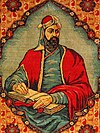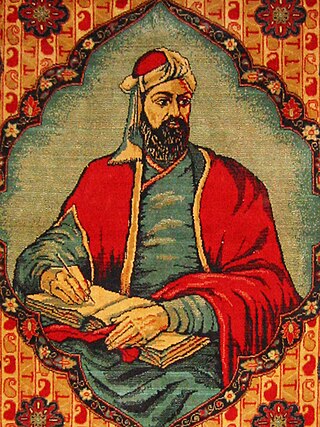
Nizami Ganjavi, Nizami Ganje'i, Nizami, or Nezāmi, whose formal name was Jamal ad-Dīn Abū Muḥammad Ilyās ibn-Yūsuf ibn-Zakkī, was a 12th-century Muslim poet. Nezāmi is considered the greatest romantic epic poet in Persian literature, who brought a colloquial and realistic style to the Persian epic. His heritage is widely appreciated and shared by Afghanistan, Republic of Azerbaijan, Iran, the Kurdistan region and Tajikistan.
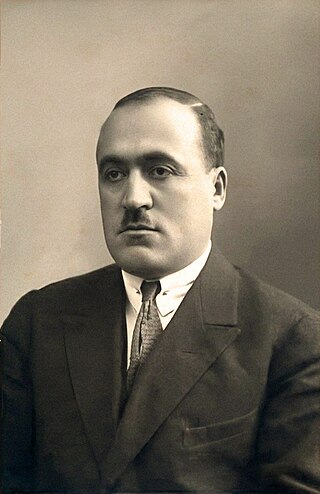
Mammad Said Ordubadi was Azerbaijani writer, poet, playwright and journalist.

Xətai District is a raion in Baku, Azerbaijan. It contains the Əhmədli municipality.

Nizami Rayon is a municipal district of the city of Baku, the capital of Azerbaijan. Its population is 201,239 and it includes the municipality of Keşlə. Of these, 25,626 lives in Keşlə municipality. The raion's area is 19.6 km².

The National museum of Azerbaijan literature named after Nizami Ganjavi is a museum in Baku, established in 1939. It is located near the entrance of Icheri Sheher, not far from the Fountains Square. The museum is considered one of the greatest and richest treasuries of Azerbaijani culture.

Istiglaliyyat Street is an arterial road in the central uptown part of Baku, Azerbaijan. It begins at Gulustan Palace, located on the southern hillside part of Baku, and continues north, then northeast, terminating at the intersection of Aziz Aliyev and Mammad Amin Rasulzade Streets at the edge of Fountains Square.

Nizami Street is a large pedestrian and shopping street in downtown Baku, Azerbaijan, named after classical Persian poet Nizami Ganjavi.

Zivar bay Garay bay oglu Ahmadbayov was the first Azerbaijani architect with higher education.
The Monument to Nizami Ganjavi, a medieval Persian poet, is located in Baku in Nizami Square, on the intersection of Istiglaliyyat, Ahmad Javad, Azerbaijan and Islam Safarli streets.

Nizami is a historical opera written in 1939 by the composer Afrasiyab Badalbeyli. It is telling about the life of the poet Nizami Ganjavi. The music and the libretto of the opera were written by Afrasiyab Badalbeyli based on the plot and motives of Mammad Said Ordubadi's novel the "Sword and Feather". The premiere of the opera took place on 12 December 1948 at the Azerbaijan State Opera and Ballet Theatre.
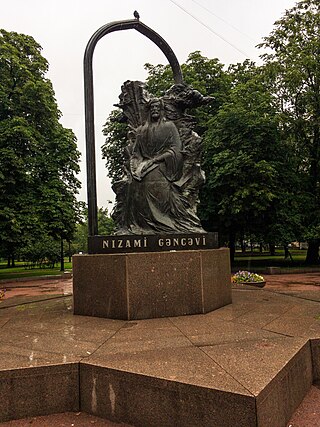
The Monument to Nizami Ganjavi in Saint Petersburg is located in a square situated between houses 25 and 27 on Kamennoostrovsky Prospekt.
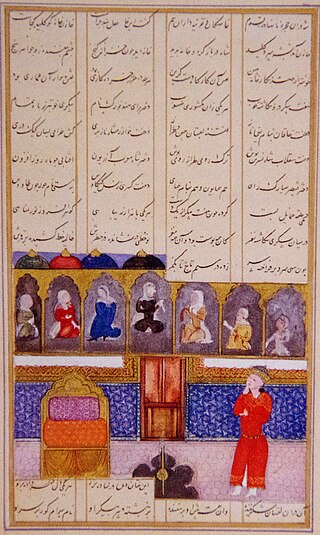
Haft Peykar also known as Bahramnameh is a romantic epic by Persian poet Nizami Ganjavi written in 1197. This poem forms one part of his Khamsa.
The monument to Nizami Ganjavi is a monument to the outstanding Persian poet Nizami Ganjavi, located in the hometown of the poet, Ganja, Azerbaijan. The monument was erected in 1946.

Ramiz Mohammad oghlu Abbasli is an Azerbaijani author, translator of fiction.
"Layla and Majnun" is the third poem of the classic of Nizami Ganjavi. This poem is included in "Khamsa" and was written in 1188 in Persian. It is based on the story of the ancient Arabic legend "Layla and Majnun" about the unhappy love of the young man Qays, nicknamed "Majnun", towards beautiful Layla. The poem is dedicated to Shirvanshah Ahsitan I, and was written on his order. There are 4600 stanzas in the poem. This poem is considered as the first literary processing of the legend.

A statue of the 16th-century Azerbaijani poet, writer, and thinker Fuzuli forms a major monument in the city of Baku. The statue was prepared by Azerbaijani sculptors Tokay Mammadov and Omar Eldarov between 1958 and 1963. The architect of the statue is Haji Mukhtarov.

"Farhad and Shirin" is the third play of the Azerbaijani poet Samad Vurgun, written in 1941. The play is based on the poem of the classic of poetry Nizami Ganjavi "Khosrov and Shirin". This play was considered one of the best examples of Nizamis poetic embodiment traditions in the Soviet literature.
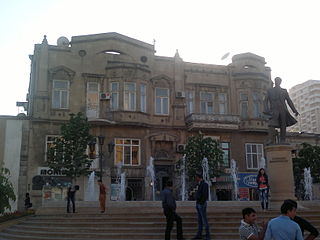
Zivar bay Ahmadbayov Monument is a monument to the Azerbaijani architect Zivar bay Ahmadbayov, located in Baku, the capital of Azerbaijan, in the Yasamal district of the city. The monument is placed in front of the Nizami Ganjavi metro station, in the park named in Zivar bay Ahmadbayov honour, on the Jafar Jabbarli street. The sculptor of the monument is Natig Aliyev, the People's Artist of Azerbaijan.

